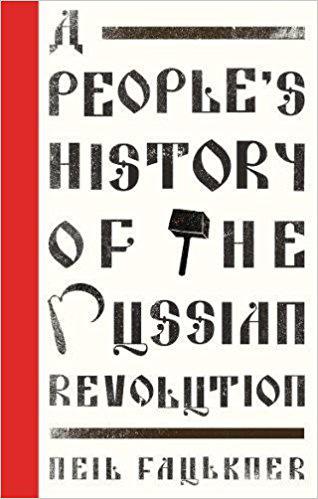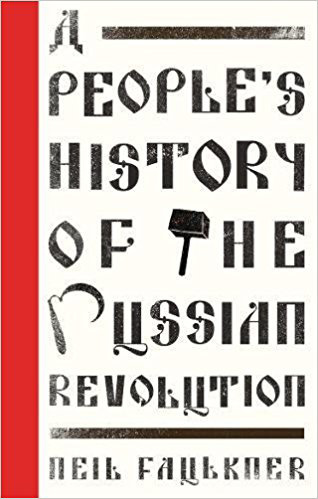 Reviewers agree that Neil Faulkner’s A People’s History of the Russian Revolution is a lively and readable account of the revolutionary events of 1917. It is also a distorted, dishonest disservice to the millions of Russian workers and peasants whose achievements Faulkner claims to celebrate.
Reviewers agree that Neil Faulkner’s A People’s History of the Russian Revolution is a lively and readable account of the revolutionary events of 1917. It is also a distorted, dishonest disservice to the millions of Russian workers and peasants whose achievements Faulkner claims to celebrate.
Why should this matter to activists today? In particular, why should it matter to people committed to nonviolent revolution?
One reason is that when times get tough, and social conflicts get hotter, and people really start hoping for a revolutionary change, they can start believing that we need a supreme leader and a vanguard party with iron discipline, that this is the proven way to transform society.
Telling the truth about the Russian Revolution is a little bit of inoculation against that.
As for nonviolent revolution, one part of that is creating a nonviolent economy. In a nonviolent economy, people won’t be tools used by others (managers, owners, commissars), but will have dignity. They will have direct democratic control of the work they do, and the conditions they do it in. Understanding the course of the Russian Revolution may help us to avoid some of the mistakes people made then as they tried to build a more humane economy.
Control from below
Let’s look at what happened to Russia’s factory workers – the people whom Lenin and the Bolsheviks claimed to have at the centre of their politics. Faulkner points out (accurately) that during the summer and autumn of 1917, ‘Across Russia, power was devolving from higher democratic bodies to lower ones, closer to the people, more directly representative, better able to give immediate expression to the evolving popular will. Among workers, power was shifting from the Soviets to factory committees....’ (p181)
Factory committees, democratically elected in pretty much every factory in the country, were a huge part of the Russian Revolution. They barely get a mention in Faulkner’s book: just two pages late on (pp183–185).
Initially, factory committees were there, as Faulkner writes, ‘to challenge the tyranny of the bosses’. (p184) As the year went on, they took on bigger roles. For example (Faulkner doesn’t tell any such stories), the factory committee at the Parviainen works saved the jobs of over 1,000 workers in Petrograd, the Russian capital, in August 1917.
Management said that only 60 percent of the fuel the factory needed had been delivered, so 1,630 workers had to be fired. The factory committee discovered that fuel was being wasted. They worked out a way to cut fuel consumption by 30 percent without affecting production and drew up new rules for stokers, machine operators and other workers. Management reluctantly accepted these ideas and kept on the workers.
Factory committees didn’t just get involved in technical matters, they also started becoming involved in management more generally.
The Opticheskii Factory Committee in Petrograd stopped management smuggling millions of roubles out of the country to the parent company in France, built a power plant to keep the factory operating, prepared models of cinematographic equipment, and dismissed managers and ‘disorganising elements’ among the workers.
Control from above
After the October Revolution, though, the factory committees lost the power they had won in earlier times, as working people became dominated by the party and the state bureaucracy.
Neil Faulkner follows other Lenin-worshippers in finding excuses for the Bolshevik-led government: the civil war (p230); the economic crisis which was made worse by the civil war (p213); and the failure of revolutionary efforts in other European states (p220).
These were huge problems for the new government, certainly, and they definitely contributed to the worsening situation of the Russian urban working classes – and the rest of the population.
But there is plenty of evidence to show that the Bolsheviks began moving against workers’ freedom before the civil war or the economic crisis really took hold. There is a classic version of this criticism in Maurice Brinton’s The Bolsheviks and Workers’ Control, published originally in 1970.
Brinton looked forward to a time when people would see that Leninism was actually ‘the last attempt of bourgeois society to reassert its ordained division into leaders and led, and to maintain authoritarian social relations in all aspects of human life.’ For him, democracy meant ordinary people taking control of their workplaces and managing them directly (for example through factory committees). The Russian Revolution was instead an example of other bodies (the party and the state) inserting themselves into the workplace and managing workers from above – the opposite of democracy.
One of the dishonest things about Faulkner’s book is that he doesn’t acknowledge that this kind of criticism exists (or try to counter the evidence it’s based on).
Workers controlled
Eight days after the Bolsheviks took power, on 3 November 1917, Lenin published a ‘Draft Decree on Workers’ Control’, which had a lot of good things in it, giving workers the right to inspect what management was up to. Brinton comments: ‘These excellent, and often quoted, provisions in fact only listed and legalized what had already been achieved and implemented in many places by the working class in the course of the struggles of the previous months.’
Brinton draws attention to three clauses in the draft, writing: ‘It is amazing that these are not better known. In practice they were soon to nullify the positive features of the previous provisions.’ Point 5 said that decisions by elected delegates of the workers were legally binding on owners but could be ‘annulled by trade unions and congresses’.
Point 6 said that, ‘in all enterprises of state importance’, all elected delegates were ‘answerable to the State for the maintenance of the strictest order and discipline and for the protection of property’.
Point 7 said that ‘enterprises of state importance’ included military industry and work ‘in any way connected with the production of articles necessary for the existence of the masses of the population’. In other words, pretty much the entire economy could be declared to be important to the state and therefore ‘answerable to the State’.
This shows that, from the beginning of Bolshevik rule, Lenin was determined to reverse the workers’ control that had already been established in Russia’s factories. He wanted to turn elected factory committees from expressions of workers’ democracy into tools the state could use to control workers.
In January 1918, at a union conference, Lenin and Trotsky made it clear that factory committees should be absorbed by and obey the trade unions, and in turn the unions would ‘inevitably become transformed into organs of the socialist state’.
Brinton describes how this worked out. First the factory committees were put under the control of the All-Russian Council for Workers’ Control.
Then the All-Russian Council for Workers’ Control was absorbed into the Supreme National Economic Council (Vesenka). The Vesenka was dominated by the unions, and also had leadership positions directly appointed by the state. To begin with, the Vesenka was allowed a ‘left’ Communist leadership – but that was removed by the party a little later.
Then the party launched a sustained campaign to curb the power of the unions. Union officials were replaced by direct Party nominees. Brinton writes: ‘These managers and administrators, nearly all appointed from above, gradually came to form the basis of the new bureaucracy.’
Faulkner does not acknowledge any of this. He writes only that the bureaucracy was left in power because of the ‘disintegration’ of the urban working class. (p239)
If only Faulkner could admit that the policies of the Bolshevik party were an intentionally disintegrating force.
Topics: Activist history


